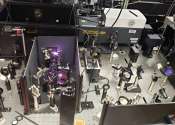SLAC National Accelerator Laboratory
SLAC National Accelerator Laboratory (SLAC) was originally called Stanford Linear Accelerator Center when it was established in 1962 on some land owned by Stanford University in California. SLAC is an arm of the Department of Energy and is managed and operated by Stanford University. SLAC has produced three Nobel Prize winners and focuses on experimental, theoretical research in elementary particle physics, atomic and solid-state physics, chemistry, biology, astrophysics and medicine. SLAC offers internships and fellowships for studies. SLAC publishes the latest in breaking physics, astrophysics and interdisciplinary research. Media inquiries are welcome and the news page is complete.
- Address
- 2575 Sand Hill Road
Menlo Park, CA 94025
- Website
- http://www.slac.stanford.edu/
- Wikipedia
- http://en.wikipedia.org/wiki/SLAC
Some content from Wikipedia,
licensed under CC BY-SA









